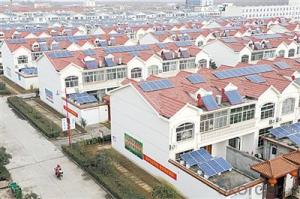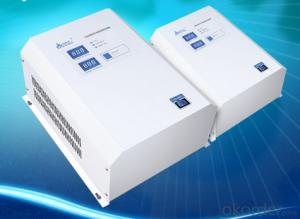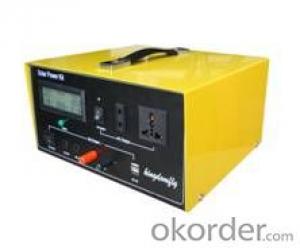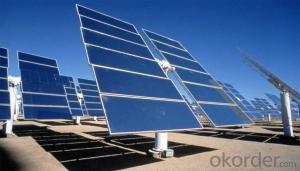Chennai Solar Energy Systems - 8kw Homeuse Grid Solar System without Battery
- Loading Port:
- Shanghai
- Payment Terms:
- TT or LC
- Min Order Qty:
- 8000 watt
- Supply Capability:
- 200000 watt/month
OKorder Service Pledge
OKorder Financial Service
You Might Also Like
Solar system advantages:
1. CE, ROHS approved.
2. High conversion efficiency, high-transmission rate.
3. Energy saving, environmental-friendly.
4. Advanced technology, strict quality control system.
5. Easy installation, safe operation, free maintenance.
6. Low MOQ, fast delivery time, long service life
| Quick Details | |||||
| Specification: | Normal | Application: | Home | Output Voltage (V): | 230~400V |
| Load Power (W): | 7800W | Solar Power (W): | 8000W | Work Time (h): | 10hours |
| Warranty: | 10years | Name: | grid solar system without battery | Model: | SLG-8KW |
| Max AC power: | 8000W | Max DC voltage: | 1000VDC | Max current: | 2*20A |
| MPPT Voltge range: | 300-800VDC | Max DC power: | 8250W | Inverter efficiency: | 98% |
| Solar panel model: | Poly solar panel 250W | ||||
| Packaging & Delivery | |
| Packaging Detail: | grid solar system without battery:Fullset system packed into cartons with pallets, 10sets can packed into 20'container, 22sets can packed into 40'container. |
| Delivery Detail: | 7-15days |
Specifications
grid solar system without battery
1)Good performance
2)High efficiency
3)Easy installation
4)Speical customs OEM
8KW homeuse grid solar system without battery
Product Description
Product Overviews:
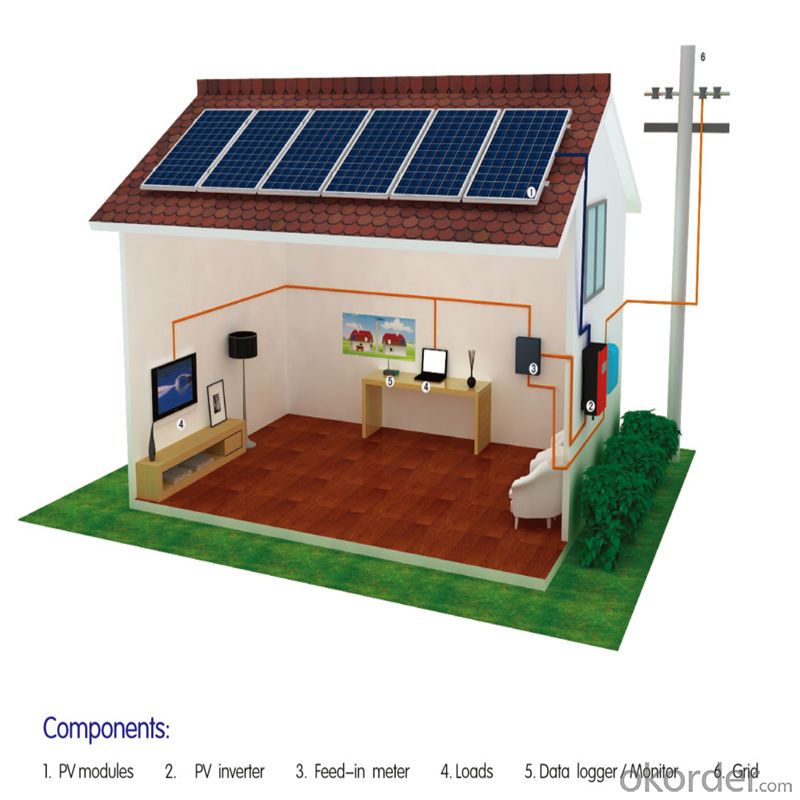
Product Parameters:
| Solar Panel / PV Module | |
| Module type | TSP-250W |
| Rated Power | 250Wp |
| Tolerance | 0-+3% |
| Open Circuit Voltage (Voc) | 36.58V |
| Short Circuit Current (Isc) | 9.15A |
| Max.Power Voltage (Vm) | 29.5V |
| Max.Power Current (Im) | 8.47A |
| Temperature coefficients of Isc (%) | 0.10/℃ |
| Temperature coefficients of Voc(%) | -0.33/℃ |
| Temperature coefficients of Pm(%) | -0.23/℃ |
| Cell efficiency(%) | ≥17.15% |
| FF(%) | 75% |
| Working Temperature Range | -40 to +85°C |
| Max Systsem Voltage | 1000V DC |
| Max Rated Fuse Current | 15A |
| Nominal operating cell temperature (NOCT): | 47°C |
| Solar cells | 6*10 polycrystalline Cells(156*156mm) |
| Size | 1640×990×40mm |
| Weight | 20Kg |
| The front cover glass | 3.2mm high transmittance,low iron,tempered glasses |
| Frame | Anodized aluminum |
| Juntion box | Protection class IP67 Rated |
| Cbles | Length:900mm, 1*4.0mm2 |
| Standard Testing Condition | 1000W/m², Cell temperature 25°C, AM1.5, Compliance with IEC61215 ,IEC61730-1 / 2 certification standards |
| PV Grid Inverter | |
| Model | Solartec D 8000 |
| Max DC Power | 8250W |
| Max DC Voltage | 1000V |
| System Start-up Voltage | 250V |
| Nominal DC Voltage | 650V |
| PV Voltage MPPT | 300v-800V |
| Max input Current | 2*16A |
| Max input short circuit current | 2*20A |
| Number of MPPT Trackers | 2 |
| Strings of each MPPT | A:1, B:1 |
| Nominal AC Output | 8000w |
| Nominal Grid Frequency Range | 50HZ |
| Max output current | 15A |
| THD of AC current | <3% |
| Nominal grid voltage range | 230-400V(3/N/PE) |
| Adjustable Displacement Factor | 0.9 overexcited…0.9underexcited |
| Number of feed-in phase | three-phase |
| Max efficiency | 98.00% |
| Euro efficiency | 97.30% |
| Mounting Method | Wall bracket |
| Reverse Polarity Protection | Short-CircuitDiode |
| DC Switch | Integrated |
| Short-Circuit Proof | Yes |
| Grid monitoring | Yes |
| Display | LCD |
| Accessory interfaces | RS485/RS232/WIFI |
| Standard Warranty | 5years |
PV Mounting Sysstem
Material is galvanized steel or aluminum,
According to different roof and installation address , have many types for choice.
Benefits of Solar Power:
Now is a great time to go solar and harvest the power of the sun. Here is our top ten list of the benefits to installing solar power:
1, When installed, solar energy is free – no resources are consumed
2, Help to lessen our dependence on heavily polluting coal power stations
3, Fossil fuels can't last forever, future generations will appreciate the effort
4, You are gaining energy independence - add battery backup power for even greater energy security
5, The cost of electricity is only going to rise – insure against that rising cost
6, Quality solar power and water adds value and appeal to your home
7, Solar PV systems are easily upgraded in future - aim to make your house a net energy producer!
8, Solar panels offer a long lifetime of low maintenance service, maybe 30-40 years
9, Your friends will think you're great!
10, You'll feel great for doing your bit for the environment!
- Q: Can solar energy systems be used in areas with limited space for ground-mounted installations?
- Yes, solar energy systems can still be used in areas with limited space for ground-mounted installations. In such cases, alternative mounting options can be utilized, such as roof-mounted solar panels or vertical solar panel installations. Roof-mounted solar panels are a popular solution for homes and buildings with limited ground space, as they utilize the available roof area to capture sunlight and convert it into electricity. Additionally, vertical solar panel installations, where solar panels are mounted vertically on walls or other structures, can also be implemented in areas where ground space is limited. These vertical installations allow for solar energy generation in tight spaces or even on building facades. Therefore, even in areas with limited space for ground-mounted installations, solar energy systems can still be effectively utilized through alternative mounting options.
- Q: How does solar energy compare to other renewable energy sources?
- Solar energy is an incredibly efficient and versatile renewable energy source that offers numerous advantages over other renewable energy sources. The first advantage is its abundance and wide availability. Derived from the sun, which is an endless source of energy, solar energy is more reliable and sustainable compared to sources like wind or hydroelectric power, which rely on specific weather conditions or geographical features. Moreover, solar energy is a decentralized source, allowing it to be generated and used at the point of consumption. This eliminates the need for extensive transmission infrastructure, which is often necessary for other renewable sources like geothermal or tidal energy. By installing solar panels on rooftops or in open spaces, individuals and businesses can generate their own electricity and reduce their dependence on the grid. In terms of its environmental impact, solar energy is considered one of the cleanest energy sources available. Unlike fossil fuels, it does not produce harmful emissions or contribute to air pollution. It also requires minimal water usage, which is especially important in areas with water scarcity, unlike hydroelectric power. By harnessing the power of the sun, solar energy helps combat climate change and reduces our reliance on finite resources. Additionally, solar energy has become increasingly cost-effective in recent years, with the cost of solar panels and installations significantly declining. This has made it more accessible to a wider range of individuals and businesses, resulting in rapid growth in the solar industry. In comparison, other renewable energy sources may still require more investment and have higher operational costs. However, it is important to note that solar energy does have limitations. It is intermittent, only available during daylight hours and susceptible to weather conditions. Nevertheless, advancements in energy storage technologies, such as batteries, are addressing this limitation by allowing solar energy to be stored for use during non-sunlight hours. In conclusion, solar energy stands out as a renewable energy source due to its abundance, reliability, decentralization, environmental benefits, and decreasing costs. As we strive for a more sustainable energy future, solar energy plays a crucial role in meeting our energy needs while minimizing our impact on the environment.
- Q: Are solar energy systems suitable for agricultural applications?
- Yes, solar energy systems are suitable for agricultural applications. They provide a sustainable and reliable source of power for various agricultural operations such as irrigation, livestock management, and powering machinery. Solar energy systems can help reduce dependence on fossil fuels, lower operating costs, and contribute to a more environmentally friendly farming practice.
- Q: Are there any health benefits associated with using solar energy?
- Yes, there are numerous health benefits associated with using solar energy. Solar power is a clean and renewable source of energy that reduces reliance on fossil fuels, thus reducing air pollution and greenhouse gas emissions. This improves air quality and lowers the risk of respiratory and cardiovascular diseases. Additionally, solar energy systems do not produce harmful emissions or noise pollution, contributing to a healthier and quieter environment.
- Q: Can solar energy systems be used in powering recycling plants or waste management facilities?
- Certainly, recycling plants and waste management facilities can make great use of solar energy systems. These systems harness the sun's power to produce electricity, which can then be utilized to operate various equipment and machinery within these facilities. It is worth noting that these facilities require a significant amount of energy to power their operations, including machines for sorting and processing, conveyor belts, and other equipment. By installing solar panels on the roofs or in close proximity to these facilities, they can generate clean and renewable electricity, thus reducing their dependence on conventional energy sources. Solar energy systems offer numerous advantages for recycling plants and waste management facilities. Firstly, they provide a reliable and consistent source of energy, as the sun is readily available in most regions throughout the year. In contrast to fossil fuels or other non-renewable sources, solar energy systems do not deplete natural resources or contribute to greenhouse gas emissions, making them environmentally friendly. This aligns perfectly with the sustainability goals of recycling plants and waste management facilities, which aim to minimize the environmental impact of waste management processes. Moreover, solar energy systems can help these facilities save on energy costs. Once the initial investment in solar panels is made, the ongoing operational expenses are relatively low. Additionally, certain regions offer incentives and financial support for the installation of solar energy systems, further offsetting the initial investment and making it financially attractive. Furthermore, recycling plants and waste management facilities often possess ample surface areas suitable for solar panel installations, such as rooftops or open fields. This facilitates the installation of a sufficient number of solar panels to meet the energy demands of these facilities. In some cases, surplus energy generated by the solar panels can even be fed back into the electrical grid, enabling the facilities to generate revenue from the excess electricity. In conclusion, solar energy systems can effectively power recycling plants and waste management facilities. They present a sustainable and cost-effective solution, reducing dependence on traditional energy sources while aiding these facilities in achieving their environmental objectives.
- Q: Can solar energy systems be used for powering airports or transportation hubs?
- Yes, solar energy systems can be used for powering airports or transportation hubs. In fact, many airports and transportation hubs around the world have already implemented solar power systems to meet their energy needs. Solar panels can be installed on rooftops, carports, or open areas within these facilities to generate clean and renewable energy. By harnessing the power of the sun, these systems can help reduce carbon emissions and dependency on fossil fuels while providing a reliable source of electricity for various operations at airports and transportation hubs.
- Q: Are there any risks of electrical malfunction or failure with solar energy systems?
- Solar energy systems come with certain risks of electrical malfunction or failure. One of the primary concerns revolves around faulty or damaged electrical connections, which can cause a loss of power generation or even spark electrical fires. Moreover, extreme weather conditions like lightning strikes or strong winds have the potential to harm solar panels or inverters, resulting in either temporary or permanent system failure. Another issue lies in the gradual degradation of solar panels over time, leading to reduced efficiency and eventual replacement. Furthermore, inadequate installation or maintenance practices may contribute to system failure or electrical malfunctions. To mitigate these risks, it is crucial to have solar energy systems installed by qualified professionals and ensure regular inspections and maintenance are conducted.
- Q: Can solar energy systems be used for powering food processing or packaging plants?
- Yes, solar energy systems can be used for powering food processing or packaging plants. Solar energy systems, such as photovoltaic panels, can generate electricity from the sun's rays. This electricity can then be used to power various processes and machinery in food processing or packaging plants. Food processing and packaging plants typically require a significant amount of energy to operate their machinery, lighting, refrigeration, and other systems. By utilizing solar energy, these plants can reduce their dependence on fossil fuels and lower their carbon footprint. Solar energy systems can be installed on the rooftops or open spaces near the food processing or packaging plants. The energy generated by these systems can be directly used or stored in batteries for later use. In some cases, excess energy can even be sold back to the power grid, providing an additional source of revenue. While the initial setup cost of solar energy systems can be high, the long-term benefits outweigh the expenses. Solar energy is a renewable and clean source of power, reducing the reliance on non-renewable resources and minimizing greenhouse gas emissions. Furthermore, solar energy systems can be integrated with energy-efficient technologies such as LED lighting, energy management systems, and heat recovery systems to further enhance the overall efficiency of food processing or packaging plants. In summary, solar energy systems are a viable and sustainable option for powering food processing or packaging plants. They offer numerous benefits, including reduced operational costs, lower environmental impact, and increased energy independence.
- Q: Can solar energy systems be used for powering military or defense installations?
- Certainly, military and defense installations can utilize solar energy systems to power their operations. In fact, numerous military and defense organizations worldwide are increasingly adopting solar energy systems as a dependable and sustainable power source. There are multiple reasons why solar energy systems are suitable for military and defense installations. Firstly, solar power is an abundant and widely accessible renewable energy source. This implies that military installations located in remote or off-grid areas can still have access to electricity without depending on costly and logistically challenging traditional fossil fuel-based generators. Additionally, solar energy systems offer a decentralized power supply option, reducing dependence on vulnerable and centralized power grids. This diminishes the susceptibility of military installations to power outages or attacks on critical infrastructure. Solar panels can be conveniently installed on rooftops, parking lots, or unused land within the military base, making optimal use of available space. Furthermore, solar energy systems necessitate minimal maintenance when compared to conventional power generation methods. This is especially advantageous for military or defense installations situated in remote or hostile environments, where regular maintenance and fuel supply for generators may be difficult or risky. Solar panels are long-lasting and durable, requiring only occasional cleaning and routine inspections. In addition to their reliability and resilience, solar energy systems offer economic advantages. By reducing reliance on fossil fuels, military installations can lower their operational costs and potentially save substantial amounts of money in the long term. These savings can then be allocated to other critical defense needs or utilized for the research and development of advanced military technologies. Moreover, the deployment of solar energy systems for military installations aligns with the global trend towards clean and sustainable energy solutions. It showcases a commitment to reducing greenhouse gas emissions and mitigating the impact of climate change, contributing to the overall sustainability objectives of military organizations. In conclusion, solar energy systems are a viable and practical choice for powering military or defense installations. They provide reliability, resilience, cost savings, and environmental benefits, making them an appealing option for military organizations seeking to optimize their energy supply and decrease their carbon footprint.
- Q: How do solar energy systems impact the reliability of electricity supply during blackouts?
- The reliability of electricity supply during blackouts can be positively influenced by solar energy systems. Homeowners and businesses can access electricity even when the grid goes down if they have a properly installed solar energy system. This is because solar panels generate electricity from sunlight, making them independent of the traditional power grid. When the sun is shining during the day, solar panels can produce electricity to meet the electrical needs of a home or business. Any excess energy generated can be stored in batteries for later use. This stored energy can then be utilized at night or during power outages, ensuring a reliable source of electricity when the grid is down. Furthermore, solar energy systems can be equipped with an inverter and a smart system that allows them to disconnect from the grid in the event of a blackout. This process, known as islanding, allows the solar panels to continue generating electricity for local consumption while isolating themselves from the main power grid. This feature guarantees that solar-powered homes and businesses can continue operating even during grid outages. The reliability of solar energy systems during blackouts depends on the size and capacity of the system, as well as the amount of energy stored in the batteries. Larger solar systems with ample battery storage can provide extended periods of electricity supply during blackouts, while smaller systems may only offer power for a limited time. It is worth noting that the reliability of solar energy systems during blackouts also relies on regular maintenance and inspections. Ensuring that the solar panels, batteries, and other components are functioning properly will optimize their performance during power outages. In conclusion, solar energy systems significantly enhance the reliability of electricity supply during blackouts. They provide a sustainable and independent source of electricity, reducing reliance on the grid and increasing resilience in the face of power disruptions.
Send your message to us
Chennai Solar Energy Systems - 8kw Homeuse Grid Solar System without Battery
- Loading Port:
- Shanghai
- Payment Terms:
- TT or LC
- Min Order Qty:
- 8000 watt
- Supply Capability:
- 200000 watt/month
OKorder Service Pledge
OKorder Financial Service
Similar products
Hot products
Hot Searches
Related keywords









